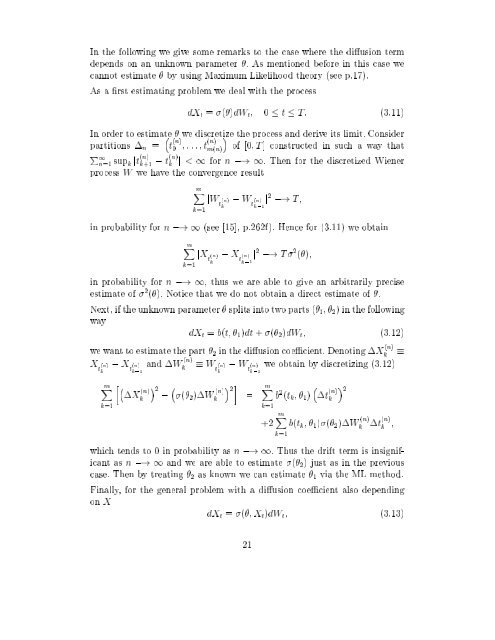Estimation in Financial Models - RiskLab
Estimation in Financial Models - RiskLab
Estimation in Financial Models - RiskLab
You also want an ePaper? Increase the reach of your titles
YUMPU automatically turns print PDFs into web optimized ePapers that Google loves.
In the follow<strong>in</strong>g we give some remarks to the case where the diusion term<br />
depends on an unknown parameter . As mentioned before <strong>in</strong> this case we<br />
cannot estimate by us<strong>in</strong>g Maximum Likelihood theory (see p.17).<br />
As a rst estimat<strong>in</strong>g problem we deal with the process<br />
dX t = ()dW t ; 0 t T: (3.11)<br />
In order to estimate we discretize the process and derive its limit. Consider<br />
partitions n = t (n)<br />
0 ;:::;t m(n) of [0;T] constructed <strong>in</strong> such a way that<br />
P 1n=1<br />
sup k jt (n)<br />
k+1<br />
, t (n)<br />
k j < 1 for n ,! 1. Then for the discretized Wiener<br />
process W we have the convergence result<br />
mX<br />
k=1<br />
jW t<br />
(n)<br />
k<br />
, W (n) t<br />
j 2 ,! T;<br />
k,1<br />
<strong>in</strong> probability for n ,! 1(see [15], p.262f). Hence for (3.11) we obta<strong>in</strong><br />
mX<br />
k=1<br />
jX t<br />
(n)<br />
k<br />
, X (n) t<br />
j 2 ,! T 2 ();<br />
k,1<br />
<strong>in</strong> probability for n ,! 1, thus we are able to give an arbitrarily precise<br />
estimate of 2 (). Notice that we do not obta<strong>in</strong> a direct estimate of .<br />
Next, if the unknown parameter splits <strong>in</strong>to two parts ( 1 ; 2 ) <strong>in</strong> the follow<strong>in</strong>g<br />
way<br />
dX t = b(t; 1 )dt + ( 2 )dW t ; (3.12)<br />
wewant to estimate the part 2 <strong>in</strong> the diusion coecient. Denot<strong>in</strong>g X (n)<br />
k<br />
X (n) t<br />
, X (n)<br />
k t<br />
and W (n)<br />
k W (n)<br />
k,1<br />
t<br />
, W (n)<br />
k t<br />
we obta<strong>in</strong> by discretiz<strong>in</strong>g (3.12)<br />
k,1<br />
mX<br />
k=1<br />
<br />
X<br />
(n)<br />
k<br />
2 <br />
, (2 )W (n) 2<br />
<br />
k<br />
=<br />
mX<br />
k=1<br />
+2<br />
<br />
b 2 (t k ; 1 ) t (n) 2<br />
k<br />
mX<br />
k=1<br />
b(t k ; 1 )( 2 )W (n)<br />
k t (n)<br />
k ;<br />
which tends to 0 <strong>in</strong> probability as n ,! 1. Thus the drift term is <strong>in</strong>significant<br />
as n ,! 1 and we are able to estimate ( 2 ) just as <strong>in</strong> the previous<br />
case. Then by treat<strong>in</strong>g 2 as known we can estimate 1 via the ML method.<br />
F<strong>in</strong>ally, for the general problem with a diusion coecient also depend<strong>in</strong>g<br />
on X<br />
dX t = (; X t )dW t ; (3.13)<br />
<br />
21
















